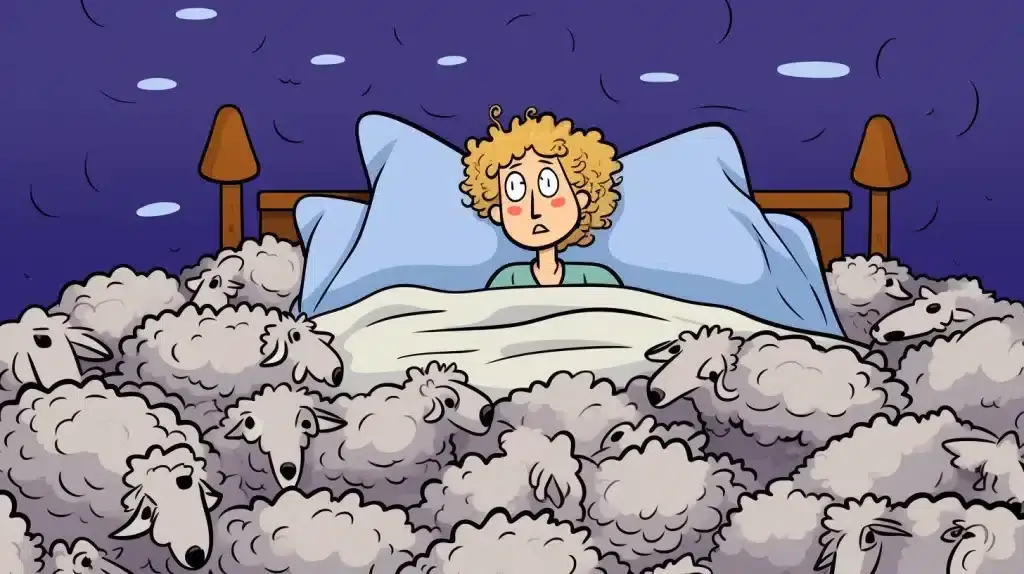Counting Sheep Helps You Fall Asleep. Imagine, if you will, a flock of fluffy sheep hopping over a quaint wooden fence, one after another, as you tally them up like an insomniac’s version of an accountant. This nighttime ritual, known as counting sheep, is as time-honored as bedtime stories and warm milk. The premise is simple: envisioning a monotonous sequence of sheep jumping endlessly should theoretically lull the mind into a state of boredom-induced slumber.

However, the effectiveness of this pastoral practice is not just a matter of folklore. Science has taken a pillow-side seat to determine whether counting these hypothetical herbivores can actually lead to the land of nod. With sleep being as elusive as a shy sheep for some, the stakes are high. Insomnia sufferers especially have been known to try just about anything to catch some Z’s, and the concept of counting sheep has often been the go-to strategy for those staring at the ceiling in the wee hours.
While there’s a certain charm to the image of a never-ending queue of sheep, the question remains: does this practice have any real merit, or is it just another woolly tale? They don’t hand out sheepskins for sheep counters, so the proof, as they say, is in the snoozing. If one were to consult the research conducted by experts, they’d find that opinions on the effectiveness of sheep counting are as varied as sheep in a meadow.
A Sheepish History

It appears that somnolent sheep have trotted through history, leaping proverbial fences long before bedtime stories were a twinkle in anyone’s eye.
From Flocks to Folklore
In Western culture, the practice of counting sheep as a means to court the sandman is both an endearing and somewhat bemusing tradition. While actual shepherds might have passed the time keeping tally of their woolly charges, city-dwellers have adopted this bucolic scene as a mental exercise in hope of inducing sleep.
The act is strikingly simple: Envision an assembly line of fluffy sheep hopping over a fence while one mentally numbers each jumper. The premise is that the monotony of counting sheep lulls the brain into a state of boredom, coaxing it towards sleepiness. Yet, this ruminant reverie has sparked debate over its efficacy.
Although encased in the warm wool of bedtime rituals, studies suggest that this shepherding simulation’s success might be more myth than reality. A study highlighted by Verywell Health posits that the technique may not be as effective as people believe, morphing the practice from a supposed slumber inducer to a mere sleep culture curio.
Those who have entertained the ovine countdown through generations may find themselves part of a large-scale psychological placebo effect—a flock of insomniacs united in a shared, if sheepish, saga.
The Sandman’s Enemy: Insomnia
In the nocturnal tussle between sheep and sleep, insomnia often emerges the victor, leaving many counting woolly jumpers instead of snoozing. Now let’s explore the nemeses that keep slumber at bay.
Causes of Insomnia
They say knowledge is power, so understanding the culprits behind insomnia is like arming oneself with a pillow in a sleepless pillow fight. First up, anxiety—that rascally ringleader of racing thoughts—can turn the brain into a veritable insomniac dojo. Next are worries, ever so sneakily tiptoeing around the mind’s corridors, making it impossible to relax enough for dreamland admission. Let’s not forget our lifestyles either; they’re chock-full of sleep-stealing shenanigans like caffeine overindulgence and screen time galore right before bed. Indeed, it seems the causes of insomnia are more numerous than the sheep one might futilely count!
Insomnia and Aging
Aging, the inevitable timekeeper, adds its own twist to the insomnia plot, like a finicky director changing the script of a snooze saga. As folks get longer in the tooth, sleep patterns may shift, with phases of deep sleep becoming as rare as a teenager volunteering to do the dishes. It’s a phenomenon that might make one ponder if Mother Nature is playing some kind of cosmic joke. But fear not, for these golden years don’t have to glitter with the harsh light of wakefulness—there are tactics and remedies to outfox the sly insomnia in its own game, so older adults can tell it, “Not tonight, dear. I have a meeting with the backs of my eyelids.”
Counting Sheep: Fact or Fiction?
https://www.youtube.com/watch?v=jSieFsNmBtI&embed=true
Ever since humans domesticated the fluffy quadruped known as the sheep, they’ve been woven into the tapestry of slumber lore. But does assigning them the task of jumping over a proverbial fence usher us into the land of nod, or is it just an old wives’ tale with a woolly twist?
Suzanna’s Study Scoop
In a twist that might make insomniacs bleat with frustration, Suzanna Payne and her esteemed colleagues found something sheepish. Published in “Behaviour Research and Therapy,” their study suggests that people focusing on the woolen parade might not find the snooze button as quickly as they’d like. It seems that sheep’s natural bouncing enthusiasm does not translate into a one-way ticket to dreamland.
The Oxford Analysis
But wait, there’s more baa-d news! Oxford University researchers plowed through the fields of sleep studies and echoed Suzanna’s findings. They rounded up a flock of sleepless humans and discovered that counting sheep is perhaps not the penultimate snooze inducer. In fact, they hypothesized that less monotonous mental images might be better escorts to the Sandman than our fluffy friends.
The Brain’s Night Shift

At night, the brain switches to its nocturnal role, much like a diligent night-shift worker preparing the workplace — in this case, the body — for some restful slumber. However, this process is not always as smooth as one might hope.
Pre-Sleep Thoughts and Troubles
They say an active imagination is a sign of intelligence, but she might disagree as she’s lying in bed, her thoughts doing acrobatics when all she really wants is to fall asleep. This nightly mental circus can range from replaying awkward conversations to pondering the mysteries of the universe—essentially any topic but the desired one of sleep. It’s a common obstacle where the more she tries not to think, the more her brain seems to churn out these unwanted pre-sleep thoughts.
The Cortisol Culprit
They say timing is everything, and this certainly applies to the hormone cortisol—known for providing that morning zap of wakefulness. Ideally, cortisol levels decline as evening approaches, signaling it’s time to wind down. Yet, when stress enters the stage, cortisol takes an unscheduled curtain call, stimulating wakefulness at all the wrong times. One’s body gets ready for action when really, it should be winding down for some restorative z’s.
So while the age-old advice of counting sheep might not be the panacea for everyone’s sleep woes, envisioning soothing scenery may just convince their brain to finally punch out for the night.
Creative Countdowns to Slumber

Searching for the snooze button on life’s remote can be a nightly game show for the restless. The quest? Outsmarting the brain’s buzzer with creative countdowns to the land of nods.
Imagery vs. Reality
They say a picture is worth a thousand z’s. Imagery, that mental escapade into serene landscapes, can trick the wakeful watchman in one’s head into punching out early. An expert suggests that by visualizing a peaceful scene, the brain engages in a form of distraction with imagery, potentially easing the transition to sleep. This beats literally counting sheep, which, let’s face it, might just lead to an overpopulated mental pasture and no shut-eye.
Monotony and Mental Gymnastics
For those who favor the less vibrant route, monotony has its charms. The simplicity of a repetitive task can lull the mind into a state of boredom-induced tranquility. Mental exercises need not be bench presses for the brain – a light workout will do. Think simple actions, like imagining a dripping tap, but without the plumber’s bill. But remember, while mental repetition can be a snooze-fest, it should be just exciting enough to keep the brain from switching over to an episode of ‘Insomnia: Why Can’t I Sleep?’.
Scientific Snooze Strategies
https://www.youtube.com/watch?v=IIeJ6OuIjR4&embed=true
Before embarking on a sheep-counting quest for a good night’s sleep, one might want to consider tactics that don’t involve hooves and wool. Here’s the lowdown on getting to the land of Nod without counting livestock.
Meditation and Relaxation
Who needs sheep when you have the power of the mind? Research suggests that methods akin to meditation—such as focusing on one’s breath or engaging in mindfulness—can be a snooze-fest in the best way. They slow the heartbeat and coax the brain into a pre-sleep serenade. It’s like giving one’s brain a lullaby to signal bedtime.
Sleep Aids and Nighttime No-Nos
Popping a melatonin supplement can be akin to sending a VIP invite to Mr. Sandman—the hormone is a nightcap that may nudge the body toward sleepsville. But watch out for lurking sleep saboteurs! While alcohol might seem like a liquid lullaby, it’s known to crash the party, leading to unrestful sleep. And those sleeping pills? They can be handy, but remember, they’re more like a rental bed than a permanent snooze solution. Keep it occasional, or one might end up with a sleep crutch harder to shake off than a nightmare about being chased by an alarm clock.
Setting the Stage for Sleep
https://www.youtube.com/watch?v=Nrwln77_1oY&embed=true
Before one embarks on the journey to the land of nod, it’s crucial to set the stage both in the physical realm and the cerebral domain. The brain adores a good routine while the body is a stickler for comfort; getting these two in cahoots can be like directing a blockbuster snooze-fest.
Staging the Room
The bedroom—she’s not just a room, she’s a sanctuary of slumber. To ensure this sanctuary is ripe for sleep, they’ve got to tend to a few basic but essential elements:
- Lights: Dim ’em down! The body’s internal clock, a real stickler for detail, takes its cues from lighting. So turning down the lights tells the body, “Hey buddy, it’s time to power down.”
- Noises: Hush those urban symphonies and suburban serenades. A consistent drone or white noise can be like a lullaby for grown-ups, but even the distant sound of a tambourine could jolt them from their pre-sleep serenity.
Staging the Mind
Now, the mind is a different species. It’s like a chatty neighbor; great when you need to borrow some sugar, not so great when you’re trying to sleep. They need to give it something to do that’s as dull as watching paint dry. They call it:
- Pre-Sleep Thoughts: Instead of counting life’s woes or tomorrow’s to-do list, they could count sheep. It’s tried, true, and a tad tedious, which is perfect for lulling that overactive brain into sleep.
These tactics are not just fluffy advice; they’re the opening act to a nightly show starring them, their bed, and blissful, uninterrupted Z’s.
The Bedtime Ballet: Rhythms and Routines

Cue the spotlight on the nightly performance many undertake in the quest for slumber. The bedroom transforms into a stage where the dance of routines and rhythmic motions aim to court the elusive sandman.
The Power of Repetition
In the grand performance of getting some shut-eye, repetition takes center stage. Nightly rituals, whether they involve dimming the lights or donning a pair of outrageously fluffy socks, signal the brain that it’s time to wind down. A study from Harvard Health suggests that creating a comfortable sleep environment and consistent pre-sleep activities can enhance sleep quality. They whisper to the cerebral audience, “Prepare for dreams,” preparing oneself for a standing ovation in dreamland.
A Fixed Bedtime Jig
While their choice of pyjamas might be far from synchronized, adherents of a fixed bedtime tend to tap dance their way to the realm of dreams more efficiently. Going to bed at the same time each night orchestrates the body’s internal clock to perform a sleep-inducing lullaby. This bedtime jig doesn’t just set the stage for a quicker curtain fall but may also improve the overall sleep quality. One doesn’t expect the sheep to line up for a cha-cha, but the consistent toss of the head onto the pillow at a set time might just be the rhythm one needs.
Alternative Sheep

Before you try counting actual sheep to nod off, let’s explore some less woolly options that just might herd you into dreamland. They may not be as fluffy, but they sure are effective.
Miscellaneous Mindfulness
Farewell to the flock! One can venture into the pasture of their mind with a relaxing scene that doesn’t necessarily involve the cliché of sheep jumping over a fence. Imagine a serene beach where waves gently lap the shore—it does the trick for a tranquil mental escape. It’s a distraction strategy that gets your brainwaves surfing instead of spiraling.
Visualization is the unsung hero here. Picture a simple, soothing scenario: maybe it’s a leaf floating down a lazy river or clouds drifting across a clear blue sky. These calming visual cues could help any toss-and-turner fall asleep faster than the sheep can say “baa”.
Technological Sheep: Modern Distractions

Before the era of digital devices, individuals attempted to lure themselves to sleep by conjuring the monotonous spectacle of sheep hopping over a fence. With the advent of technology, these fluffy jumpers have evolved into various forms of electronic entertainment that baa away the drowsiness but may lead to unintended bouts of insomnia.
Smartphones and Sleep
When it comes to getting some shut-eye, smartphones are the black sheep of the bedroom. These backlit pastures of pixels are often people’s go-to distraction technique before bed. However, browsing social media or catching up on the day’s news can transform from a quick check-in to a never-ending scroll. One minute someone is checking their phone for the time, the next they’re deep into a rabbit hole of cat videos and food blogs.
- Impact on Sleep:
- Increased brain activity from engaging content
- Suppression of melatonin due to blue light exposure
Musical Waves and Whispering Wind
Believe it or not, some people trade in counting sheep for listening to actual or virtual waves crashing against the shore or the gentle rustle of leaves known as “whispering wind.” Music and sound apps on smartphones play curated playlists that promise to transport listeners from their bed to a beach or a tranquil forest glade faster than you can say, “Sweet dreams.” These audial distractions use soothing tones to attempt to drown out the cacophony of the day and can be more effective for some than visualizing woolly jumpers.
- Sleep Inducing Sounds:
- Ocean waves
- Gentle breeze
- Soft ambient music
It seems the stand-in for our once beloved counting pastime has received facelifts and firmware updates, turning the night-time narrative from gentle leaps to digital leaps of faith in technology’s ability to send them to dreamland.
The Last ‘Baa’: Wrapping Up the Night

One might imagine the final baa of the night like the concluding note of a lullaby, a soothing signal that sleep is nigh. They’ve been diligently counting sheep, envisioning those fluffy jumpers one by one as they hop the fence.
For some, the idea is to simply tire the brain, using the counting as a form of mental muscle relaxation—a technique as traditional as warm milk before bed, but less soggy. They whisper a numeric farewell to each woolly dreamer, sending it on its merry way, perhaps to a fish’s slumber party down seas. It’s a quirky form of self-soothing, imagining each sheep’s soft baa fading into the quiet abyss of nighttime.
But does the flock actually bring forth sleep? Some would argue that it’s about as effective as asking fish to tango. The efficacy of such a ritual is often debated, with some sleep experts suggesting alternative methods, like deep muscle relaxation or visualizing scenes more tranquil than an animal high-jump competition.
Here’s a not-so-scientific breakdown:
- Counting Sheep:
- Fun rating: Pajama party with sheep? High.
- Sleep induction: Hit or miss, like finding a fish that enjoys a bedtime story.
- Deep Muscle Relaxation:
- Fun rating: If you enjoy feeling like a noodle, top marks.
- Sleep induction: Stronger contender—say goodbye to the tension.
In the end, it’s a personal counting quest. They weigh their options, let out a final giggle at the thought of sheep in nightcaps, and decide whether to invite a herd into their bedtime routine or opt for another passage to the land of nod.
Steve is the creative force behind My Unique Tales, a blog dedicated to sharing captivating stories that explore the human experience in all its complexity. With a passion for writing and a talent for crafting engaging narratives, Steve's blog is a treasure trove of imaginative tales that transport readers to other worlds and challenge them to see things from new perspectives. From epic adventures to intimate character studies, Steve's stories are always thought-provoking and emotionally resonant. With a growing following of readers who appreciate his unique voice and creative vision, Steve is quickly becoming a rising star in the world of online storytelling.






